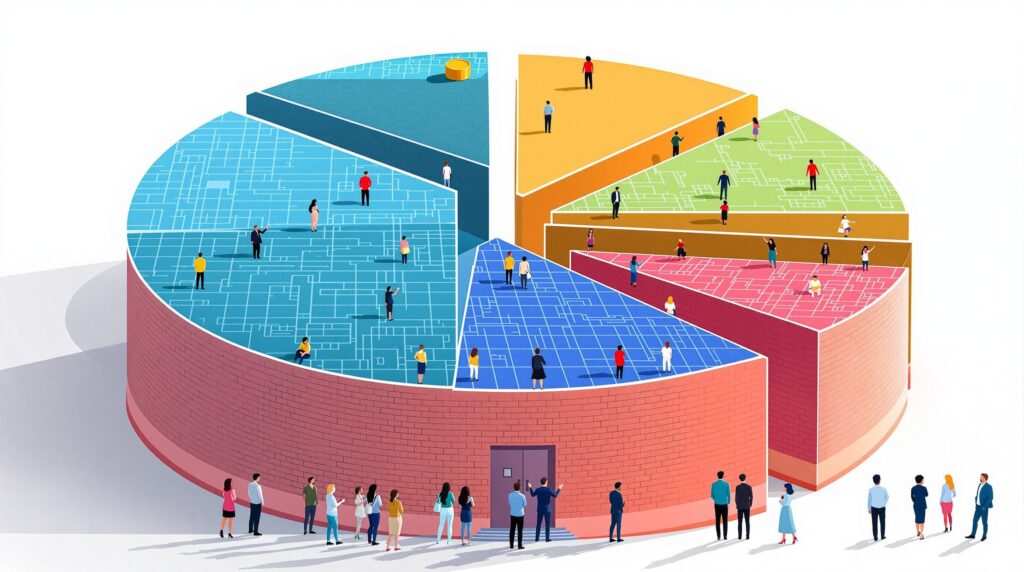[rev_slider alias=”slider-1″][/rev_slider]
Introduction to Layer 1 and Layer 2 Blockchain Solutions
As the digital landscape evolves, understanding blockchain technology becomes paramount for both developers and investors. But what exactly are blockchains and how do Layer 1 and Layer 2 solutions fit into this complex framework? Let’s dive into these foundational components.
What is a Blockchain? A blockchain is a decentralized digital ledger that records transactions across many computers in a way that the registered transactions cannot be altered retroactively. Each block in the chain contains transaction data, a timestamp, and a cryptographic hash of the previous block.
Layer 1 solutions refer to the base layer or the ‘ground layer’ of the blockchain network itself. This includes the fundamental architecture and consensus mechanisms that ensure the network’s functionality. Bitcoin and Ethereum are prime examples of Layer 1 blockchains that many are familiar with. On the other hand, Layer 2 solutions build upon Layer 1, enhancing them by offering increased speeds and scalability.
- Key Concept: Layer 1 Blockchains: This is the main structure of a blockchain network, responsible for transaction validation and consensus.
- Key Concept: Layer 2 Blockchains: These solutions sit atop Layer 1 chains and aim to solve congestion and scaling issues without altering the original protocol architecture.
The understanding of these layers is crucial as they play a significant role in determining the speed, efficiency, and scalability of blockchain networks. It’s like building a house, where Layer 1 is the solid foundation and Layer 2 adds another layer of functionality and livability.
Why Does it Matter? Layer 1 and Layer 2 solutions are crucial because they help manage blockchain network congestion, reduce transaction costs, and increase overall efficiency. These improvements are pivotal in promoting widespread blockchain adoption.
One of the revolutionary companies leveraging these layers is Jara, specializing in blockchain infrastructure within Africa. Their proprietary Layer 2 blockchain enables rapid transactions, low fees, and a scalable platform. This positions them uniquely, especially given Africa’s burgeoning digital economy projected to exceed $200 billion.
Integrating blockchain solutions tailored to specific needs, such as Jara’s focus on real-world asset tokenization, aligns with the emerging trends in cryptocurrency and beyond.
In a world increasingly leaning towards decentralized technologies, grasping the basics of Layer 1 and Layer 2 blockchains isn’t just for techies. It’s essential knowledge for anyone interested in the future of digital assets. So why not start exploring these layers and see where they fit into your digital journey?
Factors Influencing Blockchain Speed on Layer 1
Have you ever wondered why some Layer 1 blockchains operate at lightning speed while others lag behind? Let’s dive into the key factors that determine the speed of these foundational networks.
Understanding blockchain speed is essential as it affects everything from transaction costs to the network’s overall efficiency. Faster blockchains can process more transactions per second, leading to a smoother user experience.
The speed of a Layer 1 blockchain largely hinges on three main factors: block size, transaction throughput, and the consensus algorithm employed. Each element contributes to how effectively a blockchain can handle the demands of its users, influencing the level of scalability and performance.
Block Size
Block size refers to the amount of data a single block on the blockchain can hold. A larger block size allows more transactions to be included, reducing the time users must wait for their transactions to be processed. However, there is a trade-off. Larger blocks require more computational power and storage, potentially leading to centralization as only nodes with significant resources can keep up.
- Advantages of Large Block Sizes: Increases transaction capacity, reducing congestion and lowering costs for users.
- Challenges: Can increase the risk of centralization and reduce the speed if the network becomes overloaded.
User adoption and network stability are often tied to the optimal block size configuration, making this a critical factor in blockchain design.
Transaction Throughput
The term transaction throughput describes the number of transactions a blockchain can process per second (TPS). Higher throughput indicates faster processing speeds, which is crucial for applications requiring real-time data, such as financial services or gaming platforms.
- High Throughput Advantages: Allows for a higher volume of transactions, supporting broad, simultaneous activities across the network.
- Drawbacks: Higher throughput can lead to increased energy consumption and potential security vulnerabilities if not correctly managed.
Enhanced throughput often calls for innovations in technology, where techniques like sharding and parallel processing come into play, boosting the overall efficiency of the blockchain network.
Consensus Algorithms
Consensus algorithms are crucial as they ensure that all nodes in the network agree on the state of the blockchain. The choice of consensus algorithm impacts both the security and speed of data processing.
- Proof of Work (PoW): Known for strong security but slower transaction speeds due to the complex puzzle-solving process.
- Proof of Stake (PoS): Offers improved speed and efficiency by leveraging the stakes held by validators rather than computational power.
- Delegated Proof of Stake (DPoS): Further enhances speed by electing a smaller group of trusted nodes to validate transactions.
Each consensus mechanism has its trade-offs. For example, while PoW is celebrated for its robustness, alternative models like PoS and DPoS provide speed and energy advantages, arguably making them more suitable for emerging markets and digital economies like those in Africa.
In summary, blockchains operate in a delicate balance between speed, security, and decentralization. Understanding these factors is crucial for navigating the complex world of cryptocurrencies and blockchains, especially for platforms like $JARA, which are pivotal in fuel Africa’s digital asset economy.
[rev_slider alias=”text-call-cta”][/rev_slider]
The Significance of Blockchain Speed
Have you ever wondered why some blockchains are like sports cars while others feel more like a leisurely walk? The speed of a blockchain isn’t just a number on a screen; it deeply influences how effective and useful a blockchain can be. In the worlds of financial transactions, supply chain management, and decentralized applications (dApps), speed is king. Let’s break it down to see why this matters so much.
Why is blockchain speed important? Blockchain speed directly impacts the efficiency and usability of applications, affecting transaction finality, user experience, and the scalability of solutions.
Imagine a situation where you send money to someone using a blockchain. You want it to be fast, right? Faster blockchains can process transactions in seconds rather than minutes or hours. In financial transactions, this speed can mean settling payments without delay, making it especially vital in regions such as Africa where remittance and cross-border payments are common.
Impact of Speed on User Experience
Speed doesn’t just make things faster; it enhances user experience significantly. Would you rather wait 10 minutes for your transaction to confirm, or have it done in seconds? Faster blockchain solutions can dramatically improve how users interact with applications, leading to higher satisfaction. When user satisfaction rises, so does adoption. This is crucial for businesses and developers striving to reach more users and generate greater engagement.
Consider the potential outcomes for businesses operating on faster blockchains. Imagine a decentralized finance (DeFi) project that can handle thousands of transactions simultaneously, enabling a seamless experience for users engaging in lending, borrowing, or trading. Businesses and developers leveraging these efficient systems can offer Advanced infrastructure for structuring and issuance, creating more robust applications without the fear of lagging performance.
- Financial Transactions: Speed ensures that monetary transfers happen quickly, which is crucial for day-to-day commerce and finance operations.
- Supply Chain Management: Instantaneous data updates allow for more accurate tracking and reduced delays in logistics operations.
- Decentralized Applications (dApps): Quick processing power enhances user engagement, making it feasible for complex applications to run smoothly.
The ramifications of blockchain speed extend far beyond mere user preferences. They strike at the heart of how applications are structured and delivered. This technological edge is pivotal in facilitating real-time operations that organizations today crave.
“The gateway to Africa’s digital economy is through speed, creating seamless avenues for investment and economic growth.” – $JARA, driving transformative change in digital asset management.
In conclusion, the significance of blockchain speed is not just in terms of technical metrics, but in its profound impact on enhancing user experiences, driving business efficiency, and facilitating technological evolution. This importance resonates strongly in Africa, where the burgeoning digital economy stands as both a challenge and an immense opportunity for growth and development.
Layer 2 Solutions: Complementing Layer 1 Performance
In the rapidly evolving blockchain landscape, the integration of Layer 2 solutions has become pivotal in enhancing the overall performance of Layer 1 blockchains. These solutions act like express lanes in a busy traffic system, designed to offload a substantial amount of traffic from the main roads, thereby reducing congestion and improving speed.
What are Layer 2 solutions? Layer 2 solutions are technologies built on top of Layer 1 blockchains to increase the speed and efficiency of transactions, enhancing scalability while maintaining security.
Layer 2 solutions address two major challenges faced by Layer 1 blockchains: scalability and latency. By handling transactions off the main blockchain, they significantly enhance the scalability and reduce the latency users experience. For instance, Africa’s growing digital economy demands efficient financial transactions, and solutions like the $JARA token, which operates using a proprietary Layer 2 blockchain, effectively meet these demands. To further augment efficiency, Jara’s ecosystem leverages its decentralized multi-chain wallet, designed to facilitate seamless transactions across different blockchain networks.
Components of Layer 2 Solutions
- State Channels: Function similarly to a bar tab, allowing multiple transactions to occur off-chain before being settled on the main chain.
- Sidechains: Independent blockchains that run parallel to a main chain, connected by two-way pegs to transfer assets seamlessly.
- Plasma Chains: A framework that creates scalable applications by batching transactions into a single main chain transaction.
- Rollups: Consolidate and execute multiple transactions into a single batch on the main blockchain, optimizing transaction processing and lowering costs.
Each of these components plays a critical role in enhancing blockchain capabilities. For instance, state channels, like those used in messaging apps designed for the WhatsApp generation, allow users to conduct multiple interactions off-chain before finally recording them on the blockchain, thus reducing wait times and enhancing user experience. This user-friendly approach aligns perfectly with Jara’s mission of enabling Africa’s digital revolution.
Future Outlook: The Evolution of Blockchain Speed
As blockchain technology continues to evolve, several advancements are poised to redefine how we perceive transaction speed and efficiency. Expectations are high for next-generation technologies such as zk-SNARKs (Zero-Knowledge Succinct Non-Interactive Arguments of Knowledge), which promise zero-latency and exceptional scalability. The adoption of these cutting-edge solutions can lead to an unprecedented increase in blockchain throughput, benefiting industries reliant on swift and secure transactions.
Moreover, emerging trends such as artificial intelligence and machine learning-enhanced blockchains are likely to drive innovation, leading to smarter, self-optimizing networks. Jara’s AI-powered influencers with dedicated tokens already exemplify how integrating AI can enrich cryptographic applications and user engagements.
The evolution of blockchain speed is crucial for Africa’s digital economy, where the $JARA token offers real-world utility in infrastructure projects, like the tokenization of the Lagos airport, enhancing both local and global investment potential.
The continuous enhancement of Layer 1 blockchains with Layer 2 solutions and other technological innovations ensures that systems like Jara’s will remain not only relevant but essential in a digital economy that demands efficiency and agility. By bridging global capital with African assets, Jara empowers dynamic economic growth and broader financial inclusion.
[rev_slider alias=”schedule-consultation-btn”][/rev_slider]

What is the impact of network congestion on Layer 1 blockchain speed?
Network congestion significantly affects Layer 1 blockchain speed by slowing down transaction processing times. When there are too many transactions pending in the queue, it can take longer for each transaction to be verified and added to the blockchain, leading to delays. This happens because the network’s capacity is limited, and if more transactions are requested than it can handle, the overall speed decreases. Addressing congestion often involves fee adjustments or innovative consensus mechanisms in new blockchain iterations.
How do Layer 1 blockchains achieve scalability?
Layer 1 blockchains can achieve scalability through techniques such as increasing block sizes, optimizing consensus algorithms, or implementing sharding techniques. Larger block sizes allow more transactions to be processed at once, while optimized consensus algorithms decrease the time taken for transaction validation. Sharding, which involves dividing the blockchain into smaller, faster nodes, helps distribute network load, thus enhancing scalability.
Why do consensus algorithms affect blockchain speed?
Consensus algorithms affect blockchain speed because they determine how quickly and efficiently network nodes come to an agreement on the state of the blockchain. Algorithms like Proof of Work (PoW) are computationally intensive and typically slower compared to alternatives like Proof of Stake (PoS) or Delegated Proof of Stake (DPoS), which offer faster consensus by reducing computational demands and incentivizing participation in the process.
What role does decentralization play in Layer 1 blockchain speed?
Decentralization plays a critical role in determining Layer 1 blockchain speed. Generally, a more decentralized network, with numerous nodes distributed worldwide, can be slower due to the time needed for all nodes to communicate and reach consensus. However, decentralization is key to achieving network security and resilience. Balancing decentralization and speed is a current industry challenge, with solutions like Layer 2 innovations promising enhanced efficiency without compromising security.

Related Practice Areas
Explore additional areas we excel in, offering unique insights and solutions tailored to varying blockchain needs.
Read Our Client Reviews
At the heart of our blockchain solutions practice is a dedication to client satisfaction. Each case is approached with the utmost care, as reflected in the enthusiastic feedback from our valued clients.

[rev_slider alias=”slider-3″][/rev_slider]
[rev_slider alias=”slider-6″][/rev_slider]
Take the Next Step with Layer 1 and Layer 2 Blockchain Solutions
You’ve learned about the impact of Layer 1 blockchain speed and the complementary role of Layer 2 solutions. It’s time to choose partners who define excellence in blockchain innovation. At Jara, we’re dedicated to leading the industry with cutting-edge solutions that propel your ventures to new heights.
“$JARA: Bridging Global Capital to African Assets” – a mission that drives us to enhance your blockchain journey with unparalleled speed and efficiency.
Don’t just take our word for it. Explore our accolades and let our recognized expertise guide your blockchain endeavors:
| Award | Granted By | Year |
|---|---|---|
| Listed Among the “Top Blockchain Innovators of 2023” | Blockchain Digest | 2023 |
| Recognized as a Leader in “Emerging Blockchain Solutions” | Tech Futures Forum | 2023 |
| Highlighted Among the “Best Blockchain Developers 2023” | Innovation Awards | 2023 |
| Winner of “Excellence in Blockchain Speed and Efficiency” | Blockchain Today Awards | 2023 |
| Featured in “Leading Blockchain Newcomers to Watch” | Tech Insights | 2023 |
Ready to experience the future of blockchain technology with Jara? Visit our website or contact us today to learn more about how we can transform your blockchain operations.
Chinyere “Chi” Nnadi
Founder and CEO, Jara | Blockchain Specialist
Content Reviewed by Chi Nnadi and his Content Team. Chi is an experienced entrepreneur dedicated to transforming Africa’s financial ecosystem through blockchain technology. As Founder and CEO of Jara, he builds enterprise-grade infrastructure converting illiquid African assets into globally accessible digital tokens. With his proprietary Layer-2 blockchain technology, Chi bridges the gap between global investors and Africa’s growing digital asset market.
Our Content Review Process
Chi Nnadi along with Jara’s dedicated content team, pledge to offer top-notch material. Our content guidelines ensure thoroughness, reputable sources, unbiased scrutiny, among other quality metrics. Please let us know if there is anything you believe to be inaccurate.
















